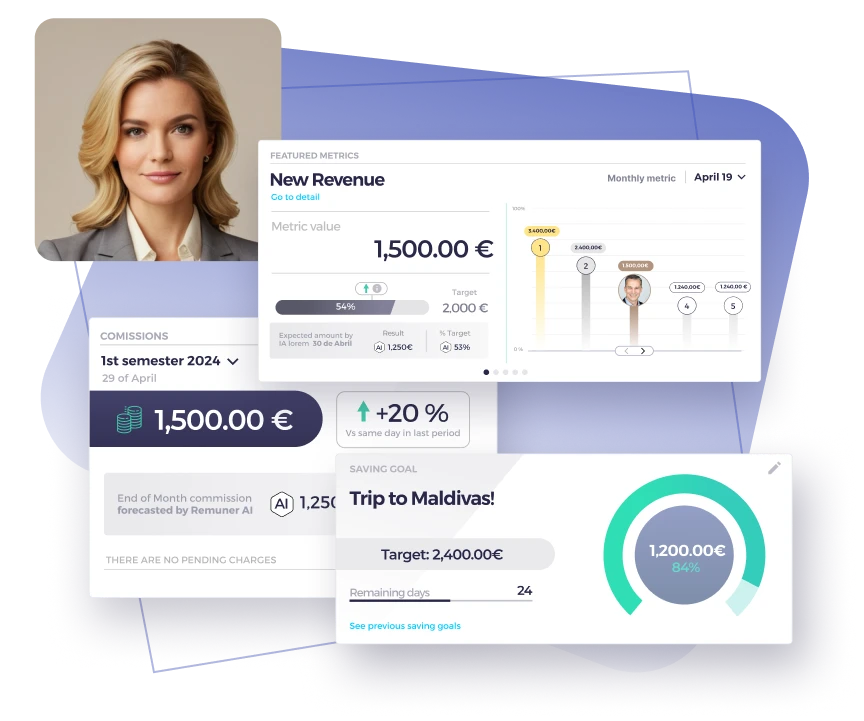Table of contents
Sales performance management (SPM) is a must for any organization relying on variable compensation to drive results. It includes strategies and processes that align sales performance with company goals. Effective sales performance management software ensures that sales teams stay motivated and rewarded. By streamlining sales processes and creating visibility around compensation plans, SPM helps organizations increase sales and meet their objectives.
Sales incentives are vital for motivating teams, but they must be well-managed to achieve the best results. With the right approach, SPM helps organizations optimize compensation plans, quotas, and on-target earnings (OTE). It offers both sales leaders and team members the visibility and control needed to improve sales performance and achieve goals.
What is Sales Performance Management?
Sales performance management is a process that aims to boost team performance through real-time tracking, coaching, and adjusting compensation. It goes beyond measuring if quotas are met. SPM involves creating realistic quotas, structuring sales incentives, and evaluating individual performance. With data-backed insights, managers can make smarter decisions to boost overall performance.
SPM also helps keep compensation plans aligned with business objectives. By using sales performance management software, businesses can automate many of the steps involved. This software makes it easier to design compensation plans, set achievable quotas, and adjust incentives as needed to meet changing business priorities.
Effective sales performance management ensures both individuals and the organization move toward the same goals. It allows businesses to track compensation plans, OTE, and quota attainment. This transparency gives both visibility and control over how well teams are performing.
Why Sales Performance Management Matters
Sales incentives are key drivers of performance. When managed correctly, they increase sales by keeping sales reps motivated. When compensation plans align with company goals, top performers get rewarded and underperformers receive the coaching they need. Without proper management, however, even the best incentives can fail to deliver results.
Sales performance management helps avoid common problems such as:
- Misaligned quotas that are either too high or too low
- Compensation plans that don’t motivate
- Lack of visibility into sales performance data
- Errors in commission payouts
With the right sales performance management software, these challenges are minimized. SPM offers real-time data on compensation, allowing both sales reps and managers to stay on top of their goals. Sales teams get clear insights into how their performance impacts their compensation and what they need to do to increase sales and hit their on target earnings.

How Sales Performance Management Drives Results
1. Quota Setting and Optimization
One of the first steps in sales performance management is setting the right quotas. Quotas need to be realistic yet challenging. If quotas are set too high, sales reps can get demotivated. If they’re too low, the company risks not reaching its goals. SPM software uses data to set quotas that encourage performance without overwhelming the team.
For instance, imagine your company is expanding into a new market. Setting appropriate quotas for that market is key. With the right sales performance management software, you can model different scenarios and choose the one that helps you increase sales while keeping your team motivated.
2. Sales Compensation Structuring
Sales compensation is a powerful tool to guide behavior. A well-designed compensation plan should motivate reps to achieve their best while supporting company goals. Sales performance management software makes designing these plans easier, allowing flexibility as priorities shift.
For example, let’s say your company wants to focus on selling higher-margin products. You could adjust the compensation structure to give higher commissions for those products. This encourages sales reps to prioritize what’s best for the company and helps increase sales.
3. Real-time Performance Visibility
Real-time performance tracking is essential for keeping sales reps on track. Sales performance management software provides dashboards that show real-time progress against quotas, current earnings, and other key metrics. This transparency keeps teams motivated and allows managers to adjust strategies quickly.
Imagine a rep is behind on their quota halfway through the quarter. With real-time data from SPM software, they can identify the problem and adjust their efforts. Managers can step in to offer coaching, making it easier for the rep to meet or exceed their OTE.
4. Sales Incentives and Coaching
Sales incentives alone can drive performance, but they are even more effective when paired with coaching. That’s why Sales performance management helps identify where reps are struggling and offers opportunities for personalized coaching. By using data to spot areas for improvement, managers can focus their coaching efforts on helping reps achieve specific goals.
For example, if a rep is struggling to close deals, SPM software can highlight this trend. Managers can then work with the rep on improving their closing techniques. Over time, targeted coaching improves both individual performance and the overall success of the team.
Components of Sales Performance Management
Sales performance management has several key components that work together to drive better results. These components include:
1. Quota Management
Setting realistic, attainable quotas is essential. Quotas must align with company goals and reflect the market’s potential. Effective quota management motivates sales reps while ensuring the company meets its objectives.
2. Sales Incentives
Incentives motivate behavior. SPM involves designing incentive structures that align with company goals and drive the right behaviors. This could include commission plans, bonuses, or other rewards.
3. Compensation Plan Design
Compensation plans must balance fixed and variable pay. With SPM software, companies can design compensation plans that reward performance while staying flexible enough to adapt to changing priorities.
4. Real-time Performance Tracking
Real-time performance visibility is a core component of SPM. SPM software provides dashboards that show current performance, making it easier to track progress toward goals and adjust strategies as needed.
5. Coaching and Feedback
Continuous coaching and feedback are essential for improving sales performance. With SPM, managers can identify gaps in performance and provide targeted coaching to help reps improve.
6. Reporting and Analytics
SPM software includes advanced reporting tools. These tools provide insights into how well compensation plans and quotas are working, allowing companies to make data-driven decisions to optimize performance.
The Role of Sales Performance Management Software
Sales performance management software is essential for optimizing sales processes. It automates key functions like compensation tracking, quota management, and performance reporting, making it easier for managers to focus on strategy. The software simplifies sales processes and gives real-time insights, helping companies align sales goals with broader business objectives.
Some key benefits of using sales performance management software include:
- Streamlining Sales Processes: Automation frees up time for sales leaders to focus on strategy instead of manual tasks.
- Increased Sales Visibility: Real-time data from the software provides visibility into sales progress, allowing sales reps and managers to make informed decisions.
- Aligning Compensation with Company Goals: SPM software ensures that compensation plans and quotas are designed to support broader business objectives.
- Data-Driven Decisions: The software provides valuable insights into sales performance, making it easier to adjust strategies to increase sales.

5 Best Practices to follow
Here are some best practices to get the most out of SPM:
- Align Sales Incentives with Company Goals: Ensure that your compensation plans support business objectives. If your goal is to drive new customer acquisition, your incentives should reward reps for bringing in new clients.
- Set Realistic Quotas: Quotas must be challenging but achievable. Use data to set quotas that motivate reps without discouraging them.
- Leverage Real-Time Data: SPM software provides real-time data that helps sales reps stay on track and allows managers to make informed decisions throughout the sales cycle.
- Regularly Adjust Compensation Plans: Compensation plans shouldn’t be static. Use performance data to review and adjust plans regularly.
- Incorporate Coaching: SPM should include regular feedback and coaching. By identifying areas for improvement, managers can provide targeted support to help reps succeed.
SPM: essential for driving results
Sales performance management, when paired with effective sales performance management software, is essential for driving results and increasing sales. By optimizing quotas, offering real-time performance tracking, and aligning compensation with company goals, businesses can create high-performing sales teams.
SPM helps ensure that your sales incentives are working as intended, driving performance, and keeping your team motivated. It also offers clear insights into individual and team performance, allowing companies to make better decisions and achieve their business goals.
How Remuner Can Help You with Sales Performance Management
Remuner offers a comprehensive platform designed to streamline and optimize every aspect of sales performance management. With our no-code compensation plan designer, you can effortlessly create and adjust sales compensation plans tailored to your business goals. Our platform connects seamlessly with your existing systems, such as CRMs and ERPs, providing real-time visibility into performance metrics, quotas, and sales incentives.
Additionally, Remuner’s AI-driven sales coach helps motivate your team by delivering personalized feedback and insights, ensuring they stay aligned with their on-target earnings (OTE) and sales goals. By automating all aspects of sales commissions and delivering actionable data-driven insights, Remuner empowers sales teams to reach their full potential while removing administrative burdens from sales leaders and finance teams alike.





